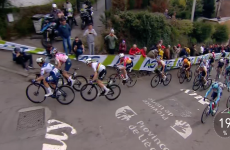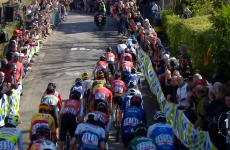Description
April 19, 2023
La Flèche Wallonne 2023 – Herve – Mur de Huy : 194,3 km
La Flèche Wallonne is the second of the three Ardennes Classics and without a doubt the most predictable –
Show more...
April 19, 2023
La Flèche Wallonne 2023 – Herve – Mur de Huy : 194,3 km
La Flèche Wallonne is the second of the three Ardennes Classics and without a doubt the most predictable – almost every edition since the turn of the millennium has ended in a thrilling drag race up the iconic finishing climb, the Mur de Huy. The race usually falls on the Wednesday between Amstel Gold and Liège-Bastogne-Liège and serves as somewhat of a mediator between these two more hectic and action-packed races. The race is one of cycling’s oldest, with its first edition taking place back in 1936, and one of the few to continue on through WWII. The earlier editions of the race were vastly different to the classic drag-race format we’ve come to know and love. These older races often exceeded distances of 250km, with the longest ever travelling for a leg-shattering distance of 300km from Tournai to Liège back in 1938. The organisers have tried to spice up the race a little over the last couple of editions by moving the penultimate climb, the Côte de Cherave, closer to the finish. While it has catalysed some late attacks, the Cherave has ultimately failed to change the outcome of the race – we still see an inevitable drag race up the Mur year after year.
Tadej Pogačar’s stunning spring Classics campaign continued on Wednesday as he captured the 87th edition of the Flèche Wallonne with a late solo uphill sprint.
Four days after winning the Amstel Gold and less than three weeks after his victory in the Tour of Flanders, Pogačar claimed his 12th title of the season ahead of Mattias Skjelmose (Trek-Segafredo) and Mikel Landa (Bahrain Victorious)
The Slovenian star stomped on the pedals with 150 metres to go on the Mur de Huy summit finish, and continued ahead all the way to the line.
Pogačar’s win further increases expectations that he will be able to end his devastating spring campaign with victory in the last Monument of the season, Liège-Bastogne-Liège, on Sunday.
Although he left it comparatively late to make his move, opting to wait until after the notoriously hard S-bend to clear, Pogačar’s attack was of such power it brooked no answer from his rivals.
“I left it all on the climb, it was a super-hard and a spectacular finish, what can I say?” Pogačar told reporters afterwards.
“Winning, for me and for everybody I think, you don’t get bored crossing the line first and I really enjoyed it. I’m really grateful I’m in such great shape now and I’ll enjoy doing this sport as long as I can.”
For all, his last effort was the one that mattered the most. Pogačar added that his UAE teammates had played a huge role in the race, saying “with 20 kilometres to go, even with 50 kilometres to go, it was really nervous.
“The team did a really good job keeping me on the front. There was one moment when I almost crashed, it was quite hectic, but we really pulled it off. That was great.”
Skjelmose recognised his chances had been more than limited, reminding reporters post-race that, “I told Danish TV this morning, I’d be grateful for a second place behind Tadej. And for the moment, the way he’s racing and with no bad luck, that [second] is a victory for everybody else.”
HOW IT UNFOLDED
Amid much debate on whether Tadej Pogačar would try an attack from distance or wait for the final ascent up the Mur de Huy, an eight-rider break containing several well-reputed racers went clear almost as soon as the flag dropped.
Belgian all-rounder Lawrence Naesen (AG2R Citroën) was amongst the race leaders, as was long-distance breakaway specialist Jetse Bol (Burgos-BH), Tour de France stage winner Søren Kragh Andersen (Alpecin-Deceuninck) and South African veteran Daryl Impey (Israel-Premier Tech). Also present in the early action were Jacob Hindsgaul (Uno-X), Georg Zimmerman (Intermarché-Circus-Wanty), Raul Garcia Pierna (Kern Pharma) and Johan Meens (Bingoal WB).
UAE Team Emirates were constantly patrolling at the front of the peloton for nearly 100 kilometres, reinforced by Ineos Grenadiers and the race reached its half-way point, the break’s gap began to shrink notably. Even the slightest rise in speed as the finish loomed on the distant horizon proved too much for David Gadu (Groupama-FDJ), who joined another French outsider, late DNS Benoit Cosnefroy (AG2R Citroën), to opt to watch the finale from the comfort of the team bus.
As Gaudu dropped back through the following cars, the intensity of UAE Team Emirates’ pursuit of the break moved up another gear as the peloton crested the Mur for the first of three times. The heightened pressure in the bunch had an immediate knock-on effect on the riders ahead, as it shattered almost completely, leaving Kragh Andersen and Zimmerman as the only survivors.
Watched by an impassive Patrick Lefevere from the side of the road, the Belgian team manager was in time for a small counter-attack by one of his riders, Pieter Serry. However, like so many of their moves in the Classics this season, it failed to bear fruit.
The second of three ascents of the Cherave allowed the peloton to sweep up all the stragglers from the break, although ZImmerman and Kragh Andersen dived back down to the River Meuse for the penultimate time with 75 seconds of daylight still in their favour.
They made it past the bell ringing out for the second-to-last lap at the top of the Mur de Huy, then Louis Vervaeke (Soudal-QuickStep) bridged across to Samuele Battistella (Astana Qazaqstan) and the quartet’s chances of staying ahead briefly flickered more strongly.
Despite the last successful break in Flèche dating from 2003, seemingly undaunted by recent race history the four pressed on. But not even a crash ripping through the rear of the peloton, with Neilson Powless (EF Education-EasyPost) one outsider affected by the fall, could stop the power of the chase. UAE’s George Bennett and Jumbo-Visma’s Sam Oomen gave the hunt added impulse and on the Cote d’Ereffe, the third last climb, while Kragh Andersen managed to find a little more energy to stick with Battistella and Vervaeke, Zimmerman was forced to let the rest of the break go.
The remaining trio ahead continued a loose, if occasionally edgy, collaboration, and interestingly rather than try and boost the break’s numbers by sending men up the road, other teams like Israel-Premier Tech and Bahrain Victorious began to push harder towards keeping the bunch together. Then when UAE made a pronounced acceleration, thanks to former winner Marc Hirschi and uphill specialist Diego Ulissi, it was final confirmation, if any were needed by this point, that UAE also wanted to go for a uphill battle and that Pogačar was set to be the last card they’d be playing.
Perhaps inspired by the sight of a roadside flag waved by his supporters, Vervaeke led over the top of the Cherave, with Ulissi, Hirschi and the rest of the bunch in hot pursuit. The Belgian even had the strength to power alone into the final two kilometres and onto the foot of the Mur de Huy.
Hirschi, though, led Pogačar onto the foot of the climb, sweeping past Vervaeke in the last 900 metres and Flèche’s 20th uphill bunch sprint finale was about to begin.
Magnus Sheffield (Ineos Grenadiers) was initially well-placed near the front of the crumpling pack, and Mike Woods (Israel-Premier Tech) was close behind. But Pogačar was already far better placed than in his previous Flèches and clearly ready to pounce.
The one rider to try to anticipate Pogačar, Romain Bardet (DSM), was blocked unintentionally by Woods as he moved forwards close to the barriers and the Canadian’s steady lead effort on the climb helped diminish the chances of any other attacks.
Then when Pogačar, having waited til late, finally made his move, it was an acceleration of such power nobody could regain ground. Even if the Slovenian was visibly exhausted at the finish by the effort he’d made, his latest triumph was as impressive as all the rest this spring. And we’re now onto 12 wins and counting.
Results :











